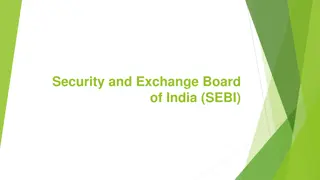Comprehensive Guide to Global Securities Operations
Explore the world of global securities operations through this detailed guide, covering topics such as course outlines, study plans, exam preparation, taking the exam, securities investment, and ordinary shares. Gain insights into how securities investment firms operate, the role of investment banks in raising funds, and the characteristics of ordinary shares. Prepare effectively for the CISI computer-based exam with recommended study plans and exam-taking tips. Dive into the realm of securities operations and enhance your understanding of the financial markets.
Download Presentation

Please find below an Image/Link to download the presentation.
The content on the website is provided AS IS for your information and personal use only. It may not be sold, licensed, or shared on other websites without obtaining consent from the author. Download presentation by click this link. If you encounter any issues during the download, it is possible that the publisher has removed the file from their server.
E N D
Presentation Transcript
Course Outline Course materials Study plans Taking a CISI computer-based exam Exam preparation course
Study Plans Recommended study plan for candidates: Read workbook prior to attending a course Attend a course Take sufficient time to revise prior to the exam Book the exam on time to avoid disappointment
Taking the Exam Available by computer-based testing (CBT) at centres globally for more information see Exam preparation in the Qualification section on the CISI website (www.cisi.org) Required to gain access: Confirmation letter and Proof of ID (both signature and photographic) Place all belongings in a designated locker Staff member will take candidate to the workstation Make sure personal details are correct
Taking the Exam 1 Hour, 50 questions Pass mark: 70% No negative marks When in doubt flag a question for review Questions can be reviewed if time permits Result will be provided almost immediately
Chapter 1 Securities Exam Questions: 12
Securities Investment Firms can borrow or raise funds from capital markets Shares and bonds Investment banks assist with raising funds Investors buy securities due to: Superior performance Diversification Regulatory oversight Liquidity High volume, relatively low cost Return in form of capital appreciation and dividend or interest
Ordinary Shares Ranks last in company value Equity is the property of ordinary shareholders Part-owner of the company Share in profits via dividends Share in remaining assets in case of liquidation Companies may issue non-voting shares Deferred shares - do not receive dividends until certain conditions are met
Ordinary Shares Register of shareholders Physical register maintained by issuer registrar Dematerialised part of register maintained in CREST Listed securities Admitted to trading on a specified recognised investment exchange Included in the official UK list maintained by the FCA or listed in a qualifying country outside the UK. Unlisted or Over-the-Counter (OTC) Bearer securities - legal title rests with the person who holds the physical security Transfer restrictions
Preference Shares Raise capital w/o diluting ownership rights of ordinary shareholders Characteristics No voting rights Fixed dividend per share, independent of profits Additional benefits Preference over ordinary shareholders in case of liquidation Dividend may be paid even when there is no dividend paid to ordinary shareholders Cumulative or non-cumulative Redeemable, participating, convertible
Debt Instruments Interest bearing securities to raise funds Borrower promises to: Repay capital at an agreed future date (unless updated) Make periodic coupon (interest) payments Lower risk because: Prior claim on company s assets in liquidation Predictable return stream Coupon can be paid Gross = without tax being withheld Net = taxes withheld from payment Default Risk
Types of Fixed Income Government bonds Domestic bonds Foreign bonds Eurobonds Convertible & Contingent Convertible bonds (CoCos) Discount securities Floating Rate Notes Asset and mortgage backed securities Index-linked bonds
Pricing Clean price - transaction price excluding accrued income Dirty price - quoted price includes accrued income Interest due to seller: Accrued interest = nominal value x coupon for the period x (days of accrual/days in coupon period) Days of accrual is calculated from the day of the previous coupon payment to the day before the transaction settlement Accrual conventions 30/360 Actual/actual Actual/360 Actual/365
Warrants Right, but not the obligation, to subscribe to an ordinary share or bond at a specified price on or before a specified date Traded on exchange Premium: price paid for the warrant Provides gearing to investor Covered warrant Issued by the company over own shares Shares will be delivered on expiry date
Depositary Receipts (DR) Financial instruments mirroring shares of a foreign company Example: DR in Russian company, traded in Germany, in EUR American DR (ADR) Issued in the US Issued in USD Reduction of costs and risks associated with investing in non-US companies Pre-Release facility Written verification by issuer re share ownership Fully collateralised with cash or other collateral Global DR (GDR) Depositary Interest (DI) Transfer Taxes
Collective Investment Vehicles Fund that pools funds from different investors Actively managed Passive / index tracking Mutual Funds/Unit Trusts Issues units that can be bought and sold Each unit represents a share in the underlying assets Open ended investment companies (OEICs) Issue shares, not units Open ended - fund manager can issue or cancel shares UCITS - harmonised fund products that can be established in all EU states Exchange Traded Products (ETP) Traded investment funds, holds selection of assets Listed on an exchange, settle like a stock. Low cost, tax efficient ETF & ETN Price determined by market/supply and demand
Collective Investment Vehicles Investment Trust Closed-ended Pricing based on NAV Different share classes Independent board of directors Gearing - can borrow to purchase additional assets Hedge Funds Investment strategies to make money in rising or falling markets Short selling Distressed securities Special situations - event driven Arbitrage
Investment Trust Foreign & Colonial Investment Trust Investment Managers Foreign & Colonial Investments Custodian Foreign & Colonial Investments Fund Value 3 billion Share Price 445p Leverage 7% NAV 468p
Collective Investment Vehicles Real Estate Funds REIT Invest in property portfolio Issues units to investors Unlisted Private Equity Funds Invest in private equity Unlisted General partner makes investment decisions Investors are limited partners Tax Transparent Funds (TTF) Aligning UK with other EU Fund centres Pooled investment vehicle Treated as investment in fund for CGT
Security Identification Number International Security Identification Number (ISIN) Unique, 12 digit number First 2 characters are country code Characters 3-11: local security number Character 12: Check digit Local securities identifier Numbering convention in local markets CUSIP - Committee on Uniform Security Identification Procedures. US and Canada SEDOL - Stock Exchange Daily Official List (LSE and Irish Stock Exchange (Euronext Dublin) Stock ticker: Identifier for listed stocks Market Identified Code: Identifier of markets Legal Entity Identifiers
Issue Methods (UK) Equities - Listing on a stock exchange Regulated by FCA and UK Listings Authority (UKLA) Monitoring of market disclosures Review of prospectus and other documentation UK listing regime Trading Record Sponsor Minimum number of shares to be distributed to the public Prospectus Continuous disclosure
Procedure for Public Issue Circulate prospectus Share issuance: Offer for subscription Offer for sale Oversubscription Offer to tender Private placement Introduction Government Bond issue Auction - accept all bids in above a minimum. Rank from high to low Individuals may be permitted to make non-competitive bids
Eurobonds Lead manager and Syndicate Underwriter, Advisers, Trustees, and Paying agents Legal advisers - due diligence Trustees - act on behalf of investors Paying agent - manage payments Issuance Bought offer - lead manager purchase whole issue and sell on to own clients Fixed price offer - Lead manager distributes to syndicate
Corporate Bonds Various structures, but issuance steps are the same Steps in bond issuance: Pre-launch Launch and roadshow Issuance
Principles of Trading Markets in Financial Instruments Directive (MiFID/UK MiFID) Best execution Investor protection Regulated Markets - Stock Exchanges Multilateral Trading Facilities (MTF) Open-order-book - provide publicly displayed liquidity. Typically small ticket, high volume Dark liquidity pools - anonymous trading Organised Trading Facilities (OTF)
Exchange Traded and OTC Exchange-traded Instruments generally have high liquidity and can be traded on to other buyers. OTC Less liquid instruments may trade off-exchange (ie, OTC). The exchange regulations and governing body specify trading procedures and detail actions to follow in case of dispute. Any legal agreements that are set in place around an OTC trade must typically be negotiated directly between the trade counterparties involved. Master legal agreements between trade counterparties may specify basic terms that will apply to all transactions. In case of dispute, trading parties may need to seek resolution through the law courts, subject to the contractual terms that they have set in place. Trades made with an OTC counterparty may have a higher risk as there may be no central clearing counterparty and exposure is directly related to the OTC counterparty chosen. However, some OTC transactions may be forwarded to a CCP for central clearing. Pricing is more complex. When the OTC market for an instrument is still immature, investment banks can often make large profits by exploiting the lack of an effective price-formation mechanism and the resultant difficulties faced by counterparties in pricing instruments accurately. To help them, trading parties may employ the services of an independent valuation agent that specialises in providing mark-to- market pricing for OTC traded instruments. As the market develops, and price- discovery mechanisms become more mature, spreads tend to narrow. As trading activity in the instrument grows, there may be benefits to bringing the instrument on-exchange. In some jurisdictions, OTC trades may be subject to more lenient posttrade reporting requirements than those conducted on a recognised stock exchange. However, under MiFID, trading participants are required to report price, volume and time of trades in listed shares, even if executed outside a regulated market (for EEA countries). Note that in some jurisdictions (for example, the UK and Ireland) OTC trades in local instruments are conducted subject to the rules of the stock exchange. Trading may take place 24 hours between trading counterparties. Participants dealing on a recognised exchange normally benefit from clearing through a CCP. Exchange provides a price discovery mechanism. Hence, pricing of exchange trades is typically relatively transparent. Trading participants are typically required to publish the price, volume and time of securities traded on a recognised stock exchange within a specified timeframe after a transaction. Trading limited to specified trading hours of the stock exchange or MTF.
Exchange Traded Funds Index ETF
Order and Quote Driven Order Driven Buyer and seller employ their own broker (as agent) Broker finds matching buyer/seller Broker makes profit from commissions Price movements on the exchange based on supply and demand Requires strong liquidity in the market Quote Driven Liquidity provided by market maker Market maker quotes buying and selling price Broker arranges transaction with the market maker
Quote Driven Trading Market Maker A Bid - 494 Ask - 499 Market Maker B Bid - 494 Ask - 498 Broker obtains prices from competing market makers Client instructs broker to buy 1000 ABC shares at best Market Maker C Bid - 494 Ask - 499 Market Maker D Bid - 495 Ask - 499 Broker executes with market maker offering best price
Order and Quote Driven Trading Principal trading Instrument is bought and sold on the firm s own account Agency trading Firm acts as intermediary on behalf of a client Agency cross - broker matches orders between own clients Riskless principal Two orders in which the execution of one is contingent on the other Market Maker Firms maintaining a firm bid and offer in a security Sales traders Proprietary traders
Computer based trading Programme Trading Trading in blocks of shares to match an index Automatically communicated Iceberg trade - sufficiently large programme trade to move the markets Algorithmic trading Mathematical based models to support trade decisions High-Frequency trading (HFT) High speed and sophisticated algorithms MiFID II provisions to ensure HFT does not have a negative impact on market quality or integrity. Order to trade ratios Minimum tick sizes Venue pricing Market making
Trade Reporting Markets in Financial Instruments Regulations (MiFIR/UK MiFIR) Reporting requirement for: Instruments admitted to trading on a trading venue By the seller Not traded with Systematic Internaliser or on trading venue SI responsible for trade reporting if traded via SI For trades with non-EU counterparties both buy and sell
Multi-listed shares Globally Registered Shares (GRS) Price differences between markets are eliminated by arbitrage Arbitrage eliminates price difference due to FX Higher liquidity Arbitrage traders need to maintain stocks in all locations Can be transferred across markets
Chapter 2 Main Industry Participants Exam Questions: 10
Investors Individual investor Own account Professional or sophisticated investor High net worth individual Institutional investor Investment Manager - Assisting clients or discretionary Brokers - execute trades on behalf of clients Inter-dealer brokers - intermediation between market makers Investment banks - intermediary between securities issuers and investor Central Banks
Client categories Retail Clients Most regulatory protection Professional Clients More experienced, knowledgeable and sophisticated Able to assess own risk Fewer regulatory protections Eligible Counterparties Regulated financial institutions Lighter regulatory regime
Custody services Keep assets secure and administer assets Administration Safe keeping, managing cashflows, arrange for delivery and receipt etc. Primary responsibility - fully protect client s assets Asset segregation between clients and clients/firm Local and global custodians Subcustodian - external agent appointed by a global custodian in a place where they do not have their own branch
Single Market Providers Agent banks specialising in providing subcustody in their markets Reciprocal arrangements Advantages of local of local provider include Country specialists Eyes and ears of custodian in local market Expert knowledge of local market practice, language and culture Perceived disadvantages May have lower credit rating Smaller size in comparison with regional providers Require due diligence to be conducted
Regional Providers Provides services over multiple markets in a region Advantages of regional providers include Possibly higher credit rating compared to single market Cross-fertilisation across multiple markets Size, regional importance, and strength of global client base Perceived disadvantages Possibly less tailored to local market Less detailed attention to clients May lack track record
Agreements Custody agreement Legal conditions Responsibilities and obligations Authority to accept instructions from fund managers Subcustody agreement Legal conditions Responsibilities and obligations Service Level Agreements (SLA) Detail the standards of service required by an investor from its custodian
Selecting a Custodian Request for Information (RFI) Statement of interest from suitable candidates Request for Proposal (RFP) Background of custodian Service capacity Account, reporting and settlement processing Safekeeping Cash management and FX Subcustodian network Pricing structure Value added services Legislation may impact the content of the RFP
Depositories Central Securities Depositories (CSD) International Central Securities Depositories (ICSD) Enable members to hold book-entry accounts, settle transactions, and provide basic custody services Eligible types of instruments include equities, government bonds, corporate bonds, and money market instruments Certificated securities holdings - either registered or bearer Dematerialised or uncertificated securities holdings - held virtually Immobilised securities holdings
Examples in selected markets UK Euroclear UK & International - dematerialised UK and some international securities CREST electronic settlement system United States Depository Trust Company (DTC) - corporate stocks and bonds, municipal bonds, money market instruments Federal Reserve Bank (FRB) - US government bonds and securities issued by federal agents Europe Euroclear France - dematerialised European securities (NYSE euronext) Interbolsa - Portuguese market LCH.Clearnet Germany Clearstream Banking Frankfurt (CREATION) CASCADE
Examples in selected markets Spain Iberclear Bolsas y Mercados Espa oles Australia CHESS - Clearing Reserve Bank of Australia RITS system Japan JASDEC - equities, corporate and municipal bonds BoJ - Japanese government bonds and treasury bills Hong Kong HKSCC Hong Kong Monetary Agency
Examples in selected markets Singapore CPD -wholly owned by SGX India National Securities Depository Limited (NSDL) Central Depositary Services (India) Limited (CDSL) South Korea Korea Securities Depository (KSD) Brazil CBLC - Equities and corporate bonds SELIC - Government debt CETIP - Corporate debt and OTC derivatives
ICSDs Integrated clearing, settlement and custody services Euroclear Bank Serves institutional clients Client base mainly banks, broker/dealers, investing institutions Holding stocks and cash - single access point to post-trade services Settlement services by batch (overnight) or real-time Custody services Clearstream Banking Settlement and custodian services TARGET2 Securities (T2S) Centralised platform of euro-denominated securities transactions Step in creation of single market























